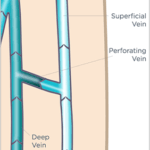A Guide to Perforator Veins
The venous system of the lower limbs consists primarily of deep and superficial veins but there is a system of veins that connect the two, these are known as perforator veins.
There are two main superficial veins: the Great Saphenous vein (GSV) and the Small Saphenous vein (SSV). These serve to drain blood from the skin and empty into the femoral vein in the groin and popliteal vein behind the knee. The deep veins of the lower leg comprise the common femoral, deep femoral, superficial femoral, popliteal, anterior tibial, as well the peroneal veins among others.

What are Perforator Veins?
Perforator veins are connector veins that link the deep lower limb veins with the superficial lower limb veins like rungs on a ladder. Each lower limb has about 150 perforator veins. Perforator veins are not the same as communicating veins which connect veins only within the same layer. In fact, perforator veins are divided into several groups based on their location namely:
- Hunterian perforators – located in the thighs
- Dodd perforators – located above the knees
- Boyd perforators – located below the knees
- Cockett perforators – located in the calves
The superficial lower limb veins empty into the deep limb veins through the perforator veins which then returns the venous blood back to the heart. Perforator veins have one-way valves designed to prevent the backflow of blood from the deep lower limb veins to the superficial limb veins.
Perforator Vein Insufficiency
Perforator venous insufficiency, also known as incompetent perforators, occurs when the valves in the perforator veins malfunction. This leads to reflux, otherwise known as reversal of blood from the deep venous system to the superficial venous system.
One cause of perforator venous insufficiency is the weakness of the perforator veins at the juncture where the perforator veins connect with the superficial veins known as re-entry points. This results in the dilatation of the perforator veins which eventually leads to reflux.
Predisposing Factors for Perforator Vein Insufficiency
Several factors that can predispose to the development of incompetent perforators include:
- Deep venous thrombosis: This causes an increased pressure in the lower limb deep venous system which can then lead to dilatation of the perforator veins
- Multiple pregnancies: This significantly increases the risk of the development of venous disorders, including perforator venous insufficiency
- Advanced age: The risks of the development of incompetent perforators increases with an increase in age
- Obesity: People who are overweight are more likely to develop perforator vein insufficiency
- Genetics: Perforator vein insufficiency has a genetic component as some people who develop this condition have a positive family history.
Signs and Symptoms of Perforator Vein Insufficiency
Symptoms of perforator venous insufficiency often vary depending on its location and the severity of perforator vein incompetence.
Some of these features are:
#1 Varicose Veins
These are large bluish swollen veins that occur around the legs and feet. They are painless unless complications arise. A characteristic of varicose veins due to perforator vein insufficiency is that the varicosities recur after treatment so long as the underlying condition persists.
#2 Leg Ulcers
These are open wounds that occur around the ankles. Increased pressure in the superficial veins secondary to incompetent perforators results in skin and tissue damage leading to the development of leg ulcers. These leg ulcers are chronic and non-healing as long as the underlying condition is not corrected.
#3 Edema
The backflow of blood into the lower limb superficial veins can result in its pooling in the legs and feet. This forces fluid out of the blood vessels and into the surrounding tissues, resulting in swelling, otherwise known as edema. In fact, this swelling is called “pitting edema” because indentation marks are left when pressure is applied over the swelling.
#4 Skin discoloration
This occurs around the ankles and is due to venous insufficiency.
#5 Leg pain
This is triggered by walking or running and is relieved by rest. Sometimes, painful leg cramps may randomly occur. Both types of pain are due to poor circulation in the lower limbs.
Diagnosis of Perforator Vein Insufficiency
The diagnosis of incompetent perforators is made based on its clinical manifestations and a Doppler ultrasound of the lower legs. The Doppler ultrasound is used to determine the location of the incompetent perforator and the severity of the reflux.
The CEAP classification is used to stage the severity of the condition; CEAP stands for clinical severity, etiology, anatomy, and pathophysiology.
CEAP scores range from C1 to C6, with C1 being the least severe and C6 being the most severe.
Treatment of Perforator Vein Insufficiency
Now, treatment is generally recommended for CEAP score C5 and C6. Treatment modalities for incompetent perforators include:
Ultrasound-Guided Sclerotherapy
This is a minimally invasive procedure.
Chemicals known as sclerosants are injected directly into the incompetent perforators after they have been located using a Doppler ultrasound. The sclerosants irritate the inner lining of the perforator veins leading to the scarring and eventual closure of these veins.
Endovascular Thermal Ablation
Endovenous Radiofrequency or Endovenous laser energy is directly applied to the incompetent perforator, thereby irritating it. This results in the development of scars within the veins and its subsequent closure.
TransLuminal Occlusion of Perforators (TRLOP)
This is an endoscopic procedure whereby a catheter is inserted under ultrasound guidance to the incompetent perforator. Heat at 185 degrees Fahrenheit is then used to occlude the vein.
An early diagnosis is important in the treatment and recovery from perforator vein insufficiency. A doctor should be seen as possible if any of the symptoms discussed above is noticed.
Medically reviewed by Dr. Susanne Woloson on 5-01-2020.
*Disclaimer: “We are a participant in the Amazon Services LLC Associates Program, an affiliate advertising program designed to provide a means for us to earn fees by linking to Amazon.com and affiliated sites.”
Read This Next
A Guide to Perforator Veins The venous system of the lower limbs consists primarily of deep and superficial veins but there is a system of veins that connect the two,...
Read MoreAs the weather warms, many of us shed our heavy winter boots and shoes for lighter, airier sandals or sneakers. However, if we are one of those who has swollen ankles and...
Read MoreWhy Are My Arm Veins Bulging? Prominent, bulging veins in your arms and hands aren't usually a sign of a serious health concern. For many patients, however, they are a...
Read MoreHave you recently noticed the development of blue veins on your chest or breasts? If so, you have probably found yourself struggling with a variety of emotions: fear, self-consciousness,...
Read More





